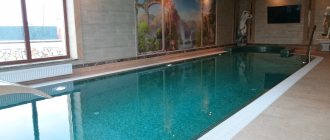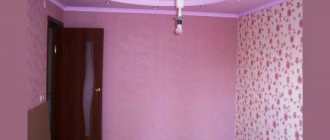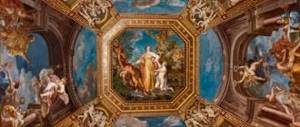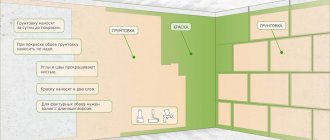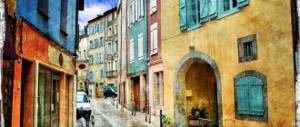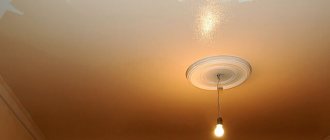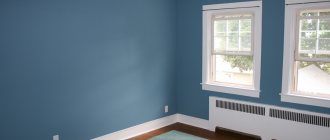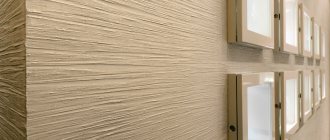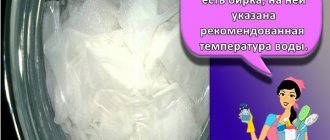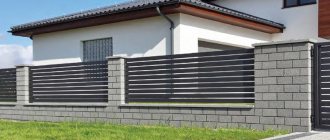Repair and decoration
04/04/2018 Anastasia Prozheva
Often one of the most important criteria when carrying out renovations is the following question: is it possible to quickly change the interior design if such a need arises? And given the fact that the style of the room is largely influenced by the walls, it turns out that with this formulation of the question, the greatest attention should be paid to “clothing for the walls,” that is, wallpaper. Since we are talking about this wall covering, it should be recalled that among those varieties that allow you to quickly and inexpensively change the interior design of an apartment, the best in our case are paintable wallpaper.
Paintable wallpaper - convenient and cute
What do you need to know before carrying out repairs and is it possible to paint wallpaper without any consequences? Which wallpaper paint is better for painting and how to choose the best option? Let's try to figure it out in more detail.
Why paintable wallpaper is better than regular wallpaper
Painting the ceiling and walls requires high-quality surface preparation, including leveling, puttying, and sanding, which not everyone can do. You can cover the walls with ready-made painted wallpaper, but mass production makes it far from original and does not always emphasize the overall style of the room. For those who want to create a unique interior in their favorite colors, painting wallpaper is ideal.
Long and painstaking preparation of the walls is no longer required; it is enough to simply cover the surface with wallpaper, and then paint it in any color of your choice. The absence of the need for putty, plaster and sanding significantly reduces the cost and simplifies the work. It takes less time to complete a task.
Advantages of wallpaper for painting:
- the ability to not only choose a color palette to your liking, but also create patterns, ornaments, designs, various stripes and other decorative elements. A wide palette of wallpaper colors for painting makes it easy to find the desired shade;
- Bored wallpaper does not need to be re-pasted, you can simply repaint it. There is no need for dismantling, there is no need to buy new materials, waste time and effort;
- a layer of paint protects the wallpaper, it is not afraid of moisture, various types of corrosion, solar radiation and wear. Unlike conventional wallpaper, the painted surface is wear-resistant and resistant to any influences, including mechanical ones;
- not all moisture-resistant finishing materials are capable, such as latex paint, of maintaining an optimal level of humidity in the room;
- a wide range of wallpaper paints for painting shades of any color cannot even be compared with the spectrum offered by manufacturers of ready-made wallpaper with a limited number of colors, patterns and designs;
- Wallpaper paint for painting allows you to hide surface defects in the form of unevenness, scratches, joints, seams, etc.
Painting the wallpaper yourself
There is nothing complicated in the painting process. To carry out the work you will need the following tools and materials:
- dye;
- fur roller and brushes;
- plastic bath;
- gloves;
- container for diluting paint;
- masking tape;
- acrylic varnish (if necessary).
Painting stages:
- Preparing the walls. The wallpaper on the walls should dry well. There is no need to rush into painting; it is better to wait for the time specified in the instructions. Usually this is 2-4 days after wallpapering. If bubbles have formed in certain areas, they must be cut and re-sealed with PVA glue. Painting should begin after the areas have completely dried.
- Dilution of paint. Here it is important to follow the proportions indicated in the instructions. Important! The diluted composition should not be too liquid.
- Applying paint. To do this, use a roller made of porous material, for example, foam rubber. During operation, smudges may form. They need to be carefully collected with the end of the roller, then paint over the area again. The same goes for the bubbles that sometimes form when painting.
Work should not be carried out with open windows. This promotes the formation of air bubbles.
Worth considering!
- The paint dries from 2 to 14 hours. After this, you can apply a second layer of paint: the color shade will be more beautiful and rich.
- Use a paint brush where it touches the floor. Pre-cover the baseboard with masking tape.
- If desired, the painted surface can be coated with acrylic varnish. This coating will provide protection from dirt, so this is an ideal solution for the kitchen, hallway and children's room.
- If you can’t find the right shade of paint, tint the white base with any of the tint dyes.
Paint for what types of wallpaper is used for painting
The construction market offers various types of wallpaper suitable for painting.
- Non-woven.
Wallpaper on a non-woven, smooth base with two viscose layers. The surface of the wallpaper is covered with foamed vinyl or pressed interlining in the form of a decorative pattern. The wallpaper adheres well and is suitable for finishing walls and ceilings. Due to its high elasticity, wallpaper does not react to wall shrinkage or the appearance of cracks, perfectly hiding minor surface imperfections. Non-woven fabric is highly resistant to moisture, which makes it possible, if necessary, to wipe the walls with a slightly wet sponge.
- Paper.
One of the cheapest versions of wallpaper for painting. Such wallpaper is impregnated with a special composition that increases water-repellent properties. The surface is embossed, similar to expensive fabric, textured plaster. Paper wallpapers are widely used.
- Glass wallpaper.
Ideal for rooms with high humidity. The wallpaper has a mineral base made of fiberglass, which allows you to maintain the original relief and decorative effect even after repeated painting. Unlike single-layer domestic options, imported glass wallpapers have a backing. They are used for finishing walls in residential, office and utility rooms. Fiberglass fabric is characterized by enhanced fire resistance.
When choosing wallpaper for painting, you should focus on the purpose of the room. For example, for bedroom walls with low intensity of use, paintable wallpaper with a paper base is perfect. Non-woven wallpaper with a foam surface will perfectly decorate the hallway and living room, as they are more wear-resistant. The best choice of wallpaper for the kitchen and children's room would be glass wallpaper, which can easily withstand frequent updates.
Paint selection
Each base has its own optimal choice of paint:
- For paper, water-based paints and varnishes are better suited.
- For non-woven fabric - water-dispersion paints.
- For fiberglass - latex and acrylic solutions.
- For linkrusta - oil or acrylic paints, as well as wax paste.
When choosing what to paint your wallpaper for painting, it is recommended that you familiarize yourself with the following information:
- Acrylic and latex paint and varnish compositions are excellent for constantly wet surfaces (kitchen, bathroom). Such paints create a film on the surface. The film disrupts the “breathing” of the surface, but prevents the negative effects of moisture on the base material.
- For heavily lit rooms, latex paint is the best choice. It does not fade from exposure to ultraviolet radiation.
- Satin reflective paint is good for kitchens, bathrooms or toilets. Coatings made from such paints and varnishes are moisture resistant and durable.
- Matte paints are distinguished by their ability to hide coating defects and also resist ultraviolet radiation well.
- Glossy coatings can improve the illumination of a room in case of lack of natural light.
- Water-based compositions are considered the easiest to apply.
- The most durable and versatile in terms of application are acrylic solutions.
- Before painting the wallpaper for painting, it is recommended to check the color intensity on a prototype. If the color is not saturated enough, a tinting element (pigment) is added to the composition.
- Water-based paints are always white. If you need to give the surface some other shade, a pigment corresponding to your wishes is added to the composition.
- Water-based paints look lighter when diluted than after completely drying on the surface.
What paint is used to paint wallpaper for painting?
Let's look in more detail at what paint to use to paint the wallpaper, because there are several types of it.
Alkyd paint
It is recommended to use alkyd wallpaper paints for painting for finishing walls and ceilings in non-residential and utility rooms. This is explained by the content of various oils and resins that have a detrimental effect on human health. This threatens not only poor health, but also the possibility of developing dangerous diseases, especially of the respiratory tract.
But alkyd paints have undeniable advantages. First of all, this is the high durability of these paints. They are moisture resistant and do not change color when exposed to the sun and light. Antifungal components added to such paints prevent rotting of the painted wallpaper. Alkyd paints are more saturated with color pigments, so they look brighter.
Wallpaper painted with alkyd paint will last at least five to six years. Over time, their appearance deteriorates a little. Alkyd paints are classified as fire hazardous substances, which also limits the scope of their possible use.
Water-dispersion paint
Currently, this is one of the most famous types of wallpaper paint for painting. This paint does not contain any harmful substances, oils or resins. This makes it as safe as possible for humans and suitable for painting wallpaper in apartments, houses and office spaces. A variety of colors adds advantages to the paint and makes it possible to choose the desired shade for the chosen interior of the room to enhance its uniqueness.
Water-dispersion paint is available in several types on the paint and varnish market. One of the varieties is latex paint, which has a water-dispersion acrylic base, intended for painting embossed wallpaper with a non-woven base and fiberglass. Quick-drying paint with virtually no odor. Perfect for painting wallpaper in the kitchen, nursery, bedroom, living room and other residential and office spaces. High air humidity in the bathroom makes the use of this paint impractical.
Acrylic paint
The absolute harmlessness of acrylic paint has made it very popular in many types of painting work. An excellent choice for painting wallpaper in residential areas, including children's rooms. The harmless composition, absence of chemicals and other harmful components make the paint safe for health and increase its popularity. Due to its visible advantages, this paint is one of the most expensive options for finishing paints and varnishes.
Professionals consider the best use of acrylic paint to be painting wallpaper with a non-woven base, although it is suitable for both glass wallpaper and wallpaper with a paper base. Due to the increased saturation, it is permissible to use acrylic paint for preliminary priming of surfaces. Wallpaper painted with this paint looks bright, does not lose its color for a long time and does not require re-painting for a long period of time.
The paint is completely odorless. When painting, no film is formed, which allows the walls to “breathe.” One of the most important advantages of this paint is its drying time - within one day.
Recommended articles on this topic:
- Arrangement of a small apartment
- Stages of renovation in an apartment
- Turnkey cosmetic repairs
Water-based paint
Water-based paints contain latex (acrylate), an antiseptic, bonding chemicals, and filler. Acrylic, water-dispersion and water-emulsion paints are considered as environmentally friendly and ideal finishing materials used for painting residential premises and office buildings. The paint has no smell.
The increased moisture resistance of water-based paint makes it possible to wash surfaces painted with water.
More information about wallpaper for coloring
Nowadays, there are many options for wall coverings, but wallpaper still ranks first in popularity. Now you can find vinyl, velor, quartz, and metallized coatings.
Wallpaper for painting is considered one of the most popular coatings, as it can be repainted several times and is more resistant to moisture.
Many people wonder which wallpaper is best for painting. Here you need to take into account not only the texture and relief of the surface, but also the material.
Coverings for painting can be made of non-woven fabric, paper or with the addition of glass. All these types are completely different, both in production and in quality.
The only thing they have in common is the ability to paint the surface. Typically, you should choose water-based or dispersion paint for this.
Generally, covers are sold unpainted, but sometimes they can be found in green, cream, blue or pink and do not need to be painted.
Paper coatings are the most popular. This is explained by the fact that paper is known to everyone. However, contrary to misconceptions, paper coatings are not so easy to work with.
Typically, paper wallpaper for painting consists of two layers. In addition, the material is impregnated with a water-repellent solution, so the surface can be painted several times.
Paper wallpaper includes a coarse fiber coating. It is distinguished by its relief, which is achieved through the use of wooden shavings.
The size of the sawdust affects the pattern - it can be large or small. Such coatings can easily be glued to the ceiling.
One of the advantages of paintable wallpaper is that it doesn't have any patterns, so it's easier to glue - you don't have to worry about joints, etc.
First, glue is applied to the surface of the paper covering, then the covering sheet is placed on the wall and pressed down with a roller.
After the wall is pasted over, you can start painting: to do this, you just need to apply the desired shade using a roller.
In addition to paper wallpaper, there is also a non-woven covering. It is a canvas made of pressed fiber.
As a rule, such a coating is quite dense. In addition to fiber, the composition includes interlining, onto which vinyl is applied to create patterns.
One of the advantages of non-woven wallpaper for painting is its ability to hide unevenness and cracks. For this reason, it is not at all necessary to level the walls before gluing.
In addition, the coating is much easier to glue - it does not swell, stretch or tear. To stick the sheet, you just need to apply the adhesive solution to the wall itself (no need to apply anything to the wallpaper).
Thanks to this, glue consumption is significantly reduced and it is much more convenient to fit the strips of fabric to each other.
Due to the fact that the composition includes non-woven material, the coating not only hides the imperfections of the walls, but also makes the surface stronger.
Video:
Therefore, it is good to glue such wallpaper in a new house, because over time the walls of the home will shrink and cracks will appear.
It should be noted that the coating will not tear due to shrinkage, and can even slightly prevent the destruction of the wall.
However, non-woven wallpaper also has its disadvantages. After pasting, they must be handled carefully, since the vinyl from which the pattern is made may crumble.
Non-woven coatings must be painted, then the decorative vinyl coating will become much stronger.
You should know that non-woven wallpaper acquires all its beneficial properties only after painting, and before that it must be handled very carefully.
Some people don’t know how to choose wallpaper to paint on the walls. The choice must be made based on the interior, walls and microclimate in the room.
Wallpaper paint for painting: colors and methods of reflection
Based on the degree of light reflection, all wallpaper paints for painting are divided into categories:
- glossy - paint that has a characteristic sheen, creating additional reflection of light rays, ideal for northern rooms and not recommended for brightly lit southern rooms;
- semi-gloss - a paint that is ideal for all living spaces, easy to clean, and has optimal light reflection. As a disadvantage, it can be noted that all irregularities are emphasized, so it is preferable to use it for smooth walls;
- matte - light-absorbing paint used in large rooms;
- semi-matte - paint with a slight sheen, perfect for bedrooms or living rooms;
- satin - paint that has a high degree of light reflection and a specific smooth base. This paint is perfect for the kitchen and bathroom, where wet cleaning is often used, but is not the best option for rooms with artificial lighting.
Types of wallpaper paints
The type of wallpaper paint is selected according to the type of wallpaper. The appearance of the walls and the wear resistance of the paint largely depend on this. Today there are three types of water-soluble paints intended for painting wallpaper:
Acrylic paint
Acrylic paint is in greatest demand. It is durable, quite moisture resistant; The range of colors on the market is huge. In addition, acrylic paint dries almost instantly.
Water soluble paint
Water-soluble PVA-based paint is the cheapest of all types. But its characteristics are inferior to other types of paints. It is afraid of moisture, so it is suitable for painting ceilings exclusively in dry rooms.
Latex paint
Latex paint adheres perfectly to wallpaper, creating a silky matte surface. High moisture resistance is the main advantage of latex paint.
When purchasing latex paint, pay attention to the gloss level indicated on the label. The higher it is, the more moisture-resistant the paint is.
Paper wallpaper can be painted with any colorful material presented above. However, latex paint works best on paper.
Non-woven and vinyl wallpapers are more prone to acrylic, but latex paint is also quite suitable for them. But if we are talking about painting the inside of the wallpaper (this is possible for some types of non-woven wallpaper), then only acrylic paint is used.
To paint fiberglass wallpaper, use any of the above water-based paints.
The best wallpaper paint for painting: selection criteria
- Covering power, or hiding power.
It is the main indicator of the quality of paintwork materials, determining the number of layers required to uniformly cover the surface with color, and paint consumption. Depending on the intensity of coloring, there are 4 classes of hiding power. Manufacturers indicate the class of their products on the label. Preference should be given to products with opacity classes 1 and 2. It is this paint that can turn a completely black wall white in just two layers. Wallpaper paint for painting with low covering power can spoil or completely paint over the texture of the wallpaper.
- Abrasion resistance.
The parameter value is also written on the label. Based on the degree of abrasion resistance, wallpaper paint for painting is divided into five classes. Classes 1 and 2 are perfect for cleaning and guarantee a long service life of the surface. It is advisable to use such paints in the bathroom, hallway, kitchen, nursery, etc.
- Whiteness level.
Manufacturers of expensive wallpaper paints for painting use high-quality pigments as components, ensuring impeccable whiteness. In budget paint options, these components are almost completely replaced with fillers, which give a dull and unsaturated color.
- Price.
The cost of paint directly depends on the quality of the binder polymer used. High quality raw materials are produced by only a few concerns, so the price is quite high. Some companies raise the price due to the brand, others position the paint as professional. There are companies that target the mass consumer and keep average prices.
Choosing paint
To paint non-woven wallpaper, you can use one of two types of paint:
1. Latex paint
It can be water-dispersed acrylic or simply water-based. Both options are well suited for painting structural wallpaper. Latex paint can be used in all rooms, as it has virtually no odor and dries quickly. It is usually available in white. The desired shade is achieved by coloring. The disadvantage of this paint is that it is almost impossible to achieve a bright color. But if you need soft pastel colors, this paint is ideal.
2. Acrylic paint
Produced on a water basis. Its cost is slightly higher than latex. Acrylic paint does not harm human health and has absolutely no odor. The surface treated with acrylic paint allows air to pass through well. Acrylic paint can be used in any room. For the kitchen and bathroom, it is better to choose paint that is resistant to high humidity. The color palette consists of many bright tones. You can choose the appropriate shade in a special studio, where the required amount of color will be added to the white paint. The process is controlled by a special program, so automatic tinting always gives the perfect result.
Paint for non-woven wallpaper can be matte or glossy. The first option will well hide minor imperfections in the coating, the second will emphasize the relief of the wallpaper. It is not recommended to use matte and glossy paints in the same room.
How to determine paint consumption for wallpaper to be painted
Pre-planning will help save time and effort. Calculate in advance what and in what quantities you may need. To calculate the required amount of wallpaper paint for painting, you need to know the area of the room to be painted, excluding windows, doorways, arches, etc. Any paint package should indicate its approximate consumption, which is determined by the type and density of the dyes.
Practice shows that to apply one layer per 1 sq.m. you will need 150-180 grams of paint. Two-layer painting requires 250 grams of paint per 1 sq.m. Rough surfaces (glass wallpaper) require less paint than wallpaper with a smooth surface (paper).
How to paint wallpaper
Paint for any non-woven wallpaper for painting is pre-tested on a small area. Often the color in the jar turns out to be less intense, so you will have to add color. The substance should not be too liquid or thick, otherwise the surface will suffer. For work you will need tools:
- Roller
. A handy item with a fleecy sheepskin top layer makes application easy. Does not leave bubbles, drips or clots on the trellises. The velor option is suitable for relief. - Brush
. Paints small areas in corners and at joints. - Paint tray
. Wide plastic tray for coloring liquid.
Window slopes, door jambs, sockets and switches are protected with special masking tape. Without wide tape, it is difficult to protect surfaces from drops splashing in all directions. The sticky strips are carefully removed after the emulsion has completely dried.
A professional sprayer treats partitions faster than a roller or brush. If it is not possible to purchase a device, then you will have to use standard tools. The walls are painted from bottom to top, evenly distributing the liquid over the wallpaper. Hard-to-reach places are treated with a thin shaving brush. It is rarely possible to complete the job the first time, so after drying another layer is applied.
How to properly apply paint for wallpaper before painting
Before you start painting the wallpaper, make sure that the wallpaper glue is completely dry. The surface must be dry, clean and free of grease. If all these conditions are met, then you can start working:
- Apply masking tape to parts not to be painted (plinth, ceiling, borders of different colors).
- Pour the paint into a special container (cuvette), in which you can roll it out with a roller.
- Completely saturate the roller with paint and remove excess by rolling the roller along the ribbed surface of the container.
- Controlling the pressure (for uniform color intensity), paint the walls with a roller from top to bottom.
- It is more convenient to paint hard-to-reach places (corners, near the ceiling and baseboard, etc.) using a brush.
To emphasize the structure of the wallpaper, it is better to use a smooth roller that paints only convex details and patterns. The quality of painting tools requires special attention. The brush should be strong with hairs that are difficult to pull out, the roller parts should be durable, etc.
Paint colors for wallpaper for painting are selected in accordance with the overall interior of the room.
Cooperating with is reliable and prestigious. The specialists working here are professionals of the highest level. operates throughout Moscow and the Moscow region.
Wallpaper paint colors: what palette to use
Having found out which paint is best for wallpaper, let's figure out what colors of wallpaper paint are most often used when decorating the interior of a room. Here are the main differences:
- Water-based paints have a very rich palette of colors and smallest shades.
- As for water-dispersion paints, they are usually white.
It may seem reasonable to ask a question that any person who is thinking of carrying out renovations in an apartment or in a separate room has the right to ask: what is the point of choosing white when there is such a rich palette of colors? We answer: paint tinting is used for similar purposes. In other words, before painting the wallpaper, a certain color is added to the coloring composition.
Paint tinting
When creating a color scheme, you can mix different colors, choosing the tone necessary for your interior. You can create pearlescent, golden, bronze and any other shade you like. In special departments of stores that sell paint and varnish products, experienced specialists will select exactly what you need.
Related article: How to restore a chair with your own hands?
It is for this reason that it is not recommended to tint such paints yourself. If you do not have the necessary experience in carrying out such work, we advise you to contact specialists. This is exactly what most reviews say from those who, without proper qualifications, risked doing the tinting with their own hands.
Helpful information! One of the most modern and high-tech methods is to create colors using a computer. So, if you have some remaining paint, but the painting has not been completed and you still need a certain amount of coloring composition, then a specialist will select the required color with perfect accuracy using computer tinting. With the help of a special tinting machine, store employees will quickly and efficiently help you tint exactly the color you ask for, and its match will be perfect.
Main characteristics of water-dispersion paints
The paint is based on a certain type of polymer. To choose the optimal dye, you need to know its composition, characteristics and scope of application.
- A regular water-based emulsion is the simplest and cheapest option. But for rooms with high humidity, water-based paint should not be used, since it has low moisture resistance.
- Acrylic is a type of latex. The main substance of this dye is acrylic resins. Water-dispersion coatings based on acrylic composites are the most resistant to dry abrasion. After drying, the composition forms a reliable coating, the surface of which can be washed with a damp sponge. Colors retain their original brightness throughout use. But for rooms with high humidity it is better not to use acrylic paint.
- Acrylic-latex (with the addition of butadiene styrene) has a wide range of applications due to its low degree of vapor permeability. Can be applied to wallpaper in damp areas. Its cost is quite high.
- Latex (butadiene styrene) paint is highly resistant to moisture and mechanical damage. But at the same time it is quite sensitive to ultraviolet radiation. It is advisable to use it for painting rooms with high humidity that require regular washing of walls, for example, kitchens and bathrooms.
The optimal paint for non-woven wallpaper is acrylic. But it can only be used in living rooms with normal humidity. For bathrooms and kitchens, it is more advisable to use latex dyes.
In addition, interior paints come in shiny and matte finishes. When choosing, you need to decide on this criterion.
Interior paint can be of several types.
- Glossy. Suitable for dimly lit rooms. May cause discomfort in well-lit rooms. Has the property of highlighting surface defects. Rarely used in residential premises.
- Semi-gloss. Thanks to its reflective properties, it makes the room brighter. It is good to paint wallpaper in children's rooms and kitchens.
- Semi-matte. Looks good on bedroom walls. Thanks to its gloss, it smooths out small defects.
- Matte. Masks minor surface irregularities. Suitable for large rooms.
- Satin. Abrasion resistant, durable. Gives a nice smooth finish.
